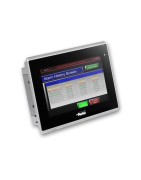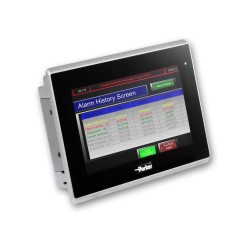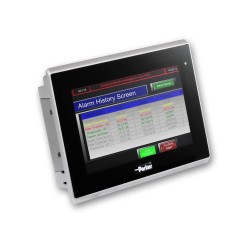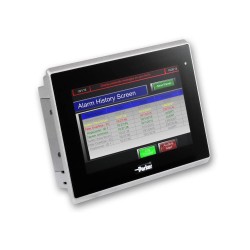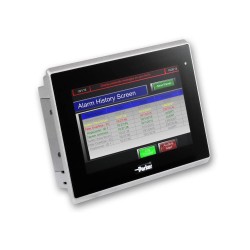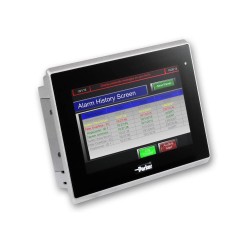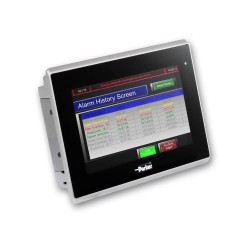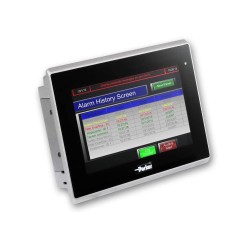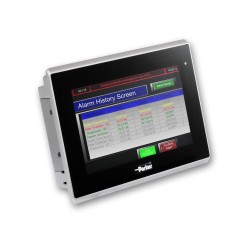PT Parker PAC Terminal
====PAC Terminal – the Perfect thin-client HMI for the Parker Automation Controller====
The PAC Terminal (PT) is a thin client HMI developed to work seamlessly with the Parker Automation Controller (PAC). With the PAC handling the control and HMI logic, the PT is responsible for displaying the embedded HMI as well as sending touch screen input from the user back to the PAC. As a thin client, the PT significantly reduces the overall system costs when compared to a traditional HMI—especially if it is desired for multiple PTs to connect to a single PAC.
Brief Specs:
• 7, 10.1, 15.6” 16:9 wide-screen options
• Bezel available in aluminum or plastic
• Analog-resistive touch technology
• Running Android with Parker’s Remote Manager (RemoteMgr) App
• Thin-client for the PAC controller and Parker XT Xpress Terminal stand-alone HMI
• 12, 24 VDC power
Download the data sheet for more detailed specifications
====About the Parker PAC and PAC Terminal all-in-one Machine Control Solution====
The PAC is Parker’s all-in-one machine controls solution that combines PLC, HMI, and motion control functionality into a single device. Likewise, the PAC is programmed using a single integrated development environment (IDE) called Parker Automation Manager (PAM).
Parker has chosen to standardized on the IEC 61131-3 programming language and PLCOpen motion control function blocks. This choice provides machine builders the ability to use traditional ladder diagram (LD) but also to take advantage of the latest control languages available such as structured text (rain), Continuous Function Chart (CFC) and Sequential Function Chart (SFC). IEC 61131-3 brings object oriented-like programming capabilities to the automation industry with the ability to create custom function blocks, libraries, and various data types. This allows OEMs to create modular code that can be re-used which significantly reduces the overall time to develop machines.
The PAC makes motion control easy. Not only does it support the PLCOpen environment but it comes packed with tools such as the CAM table editor, CNC capabilities using .dxf to G-code converters, graphical motion path editing, and pre-made inverse kinematic function blocks for robotics such as delta and H-bots, SCARA, and gantry systems. Tightly coupled motion is made possible by leveraging the speed and distributed clock capability of EtherCAT. In addition to modular code design, EtherCAT allows modular hardware design by allowing users to connect to a near-unlimited number of EtherCAT devices including the PAC I/O local and remote I/O system, Parker P-series motors and drives, PSD servo drives, AC30 drives, and also 3rd-party EtherCAT devices. Although EtherCAT provides the backbone to the Parker control strategy, the PAC is capable of communicating Ethernet/IP, Profinet, Profibus, Modbus TCP, Ethernet TCP/IP to ensure that it can work in any control system architecture.
Control engineers have two options when developing their HMI in PAM: either using WebVisu, a European-style visualization platform that is designed to easily integrate with the IEC 61131-3 programming language, or Parker’s incredibly popular and easy-to-use HMI, embedded Xpress. Both WebVisu and embedded Xpress provide remote capabilities by taking advantage of web publishing technology. Any remote client such as a browser, or mobile device using Parker’s Remote Manager (RemoteMgr) App can connect to the embedded HMI simply by entering in the PAC’s IP address and target application. This means that an unlimited number of devices can connect to the PAC including multiple PT units.
The ability to provide a single solution and programming environment for PLC logic, HMI local and Remote visualization, as well as motion control makes the PAC an all-in-one machine controller capable of solving the most difficult applications with ease and reduced time to market.
The PAC Terminal (PT) is a thin client HMI developed to work seamlessly with the Parker Automation Controller (PAC). With the PAC handling the control and HMI logic, the PT is responsible for displaying the embedded HMI as well as sending touch screen input from the user back to the PAC. As a thin client, the PT significantly reduces the overall system costs when compared to a traditional HMI—especially if it is desired for multiple PTs to connect to a single PAC.
Brief Specs:
• 7, 10.1, 15.6” 16:9 wide-screen options
• Bezel available in aluminum or plastic
• Analog-resistive touch technology
• Running Android with Parker’s Remote Manager (RemoteMgr) App
• Thin-client for the PAC controller and Parker XT Xpress Terminal stand-alone HMI
• 12, 24 VDC power
Download the data sheet for more detailed specifications
====About the Parker PAC and PAC Terminal all-in-one Machine Control Solution====
The PAC is Parker’s all-in-one machine controls solution that combines PLC, HMI, and motion control functionality into a single device. Likewise, the PAC is programmed using a single integrated development environment (IDE) called Parker Automation Manager (PAM).
Parker has chosen to standardized on the IEC 61131-3 programming language and PLCOpen motion control function blocks. This choice provides machine builders the ability to use traditional ladder diagram (LD) but also to take advantage of the latest control languages available such as structured text (rain), Continuous Function Chart (CFC) and Sequential Function Chart (SFC). IEC 61131-3 brings object oriented-like programming capabilities to the automation industry with the ability to create custom function blocks, libraries, and various data types. This allows OEMs to create modular code that can be re-used which significantly reduces the overall time to develop machines.
The PAC makes motion control easy. Not only does it support the PLCOpen environment but it comes packed with tools such as the CAM table editor, CNC capabilities using .dxf to G-code converters, graphical motion path editing, and pre-made inverse kinematic function blocks for robotics such as delta and H-bots, SCARA, and gantry systems. Tightly coupled motion is made possible by leveraging the speed and distributed clock capability of EtherCAT. In addition to modular code design, EtherCAT allows modular hardware design by allowing users to connect to a near-unlimited number of EtherCAT devices including the PAC I/O local and remote I/O system, Parker P-series motors and drives, PSD servo drives, AC30 drives, and also 3rd-party EtherCAT devices. Although EtherCAT provides the backbone to the Parker control strategy, the PAC is capable of communicating Ethernet/IP, Profinet, Profibus, Modbus TCP, Ethernet TCP/IP to ensure that it can work in any control system architecture.
Control engineers have two options when developing their HMI in PAM: either using WebVisu, a European-style visualization platform that is designed to easily integrate with the IEC 61131-3 programming language, or Parker’s incredibly popular and easy-to-use HMI, embedded Xpress. Both WebVisu and embedded Xpress provide remote capabilities by taking advantage of web publishing technology. Any remote client such as a browser, or mobile device using Parker’s Remote Manager (RemoteMgr) App can connect to the embedded HMI simply by entering in the PAC’s IP address and target application. This means that an unlimited number of devices can connect to the PAC including multiple PT units.
The ability to provide a single solution and programming environment for PLC logic, HMI local and Remote visualization, as well as motion control makes the PAC an all-in-one machine controller capable of solving the most difficult applications with ease and reduced time to market.
